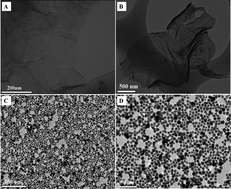Electrochemical detection of nitrite based on glassy carbon electrode modified with gold–polyaniline–graphene nanocomposites
Abstract
First, polyaniline–graphene oxide (GO–PANI) nanocomposites were prepared by the in situ polymerization of aniline in the presence of graphene oxide (GO). Next, the GO–PANI nanocomposites were reduced to polyaniline–graphene (G–PANI) nanocomposites by a green electrochemical reduction method. Finally, a thin layer of nearly monodispersed Au nanoparticles with a uniform size (∼12 nm) was coated on the surface of the G–PANI nanocomposites. Moreover, the as-prepared Au–polyaniline–graphene (Au–G–PANI) nanocomposites can be used as a sensing electrode material for the electrochemical detection of nitrite (NO2−). Compared with other common modified electrodes, the Au–G–PANI/GCE shows an obvious oxidation peak of NO2− with a larger peak current, and gives a wider linear range from 0.1 to 200 μmol L−1, with a detection limit of 0.01 μmol L−1 (S/N = 3). Besides, the oxidation process of NO2− on the Au–G–PANI/GCE is proven to be a surface-controlled process involving the transfer of two electrons. The present study widens the applications of graphene-based nanocomposite materials in the electrochemical detection of environmental pollutants.


 Please wait while we load your content...
Please wait while we load your content...